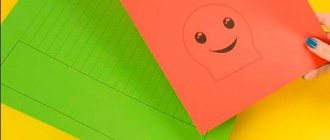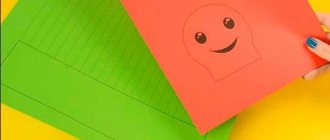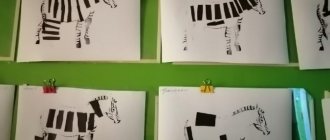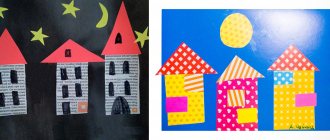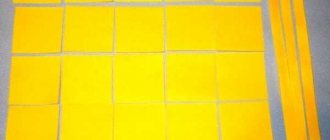Squirrel is one of the sweetest and cutest inhabitants of the forest and park. In recreation areas, these nimble animals are not afraid of people, and children like to feed them nuts. It turns out that the squirrel is an application that kindergarteners will make with pleasure.
Preparing for an application on the theme “Animals”
As in other classes on traditional appliqué in the middle group, the teacher prepares materials. So, for the topic “Animals” you will need the following materials:
- The basis for work is sheets of paper or cardboard in A5 format (white or colored). If collective work is expected, then you will need a sheet of whatman paper: the teacher tints it or draws a certain background (forest landscape, farm, etc.).
- Details made of colored paper. Their size is determined according to the format of the base.
- Glue, brushes, oilcloths, rags.
It will be very interesting for the children if the teacher offers them fabric parts, for example, made of felt, instead of the usual paper parts.
The teacher can surprise the children by offering them felt instead of the usual colored paper.
If an unconventional application of leaves is planned, then the teacher also offers them. You can collect foliage with your children on a walk in the fall or ask your parents to do it.
If you plan to conduct a lesson using the cutting or mosaic technique, then the children themselves should start making the starting material - they roll up lumps from napkins, tear the paper into pieces. Indeed, in this case, preparing the details is an important part of the lesson, necessary for the development of fine motor skills. The teacher draws the outline of the animal or cuts out its silhouette.
When working with cutting or mosaic techniques, the children themselves are engaged in making parts in the middle group.
Animal made from natural materials
Autumn leaves are the best raw material for crafts. Collect and dry bright maple, oak, and red grape leaves. Don't forget about pine cones and acorns. It's fun to make different creations out of them.
To make the herbarium bright, put the leaves to dry not just between the pages of books, but wrapped in napkins or something moisture-absorbing. Replace them with new ones from time to time. And voluminous flowers or cones are dried in salt or semolina.
It is no less interesting to work with cereals and porridges. To complete the following work, prepare PVA glue, background, rice, millet (or buckwheat), semolina, and paints. A pencil and carbon paper will come in handy if you draw the outline in advance.
Place white rice along the outline. First, add semolina (on PVA glue), then add peas (in the form of nuts).
Sunflower seeds or black beads will serve to create the nose and eyes. But choose the main color of the body yourself. You can cover it with buckwheat. And if you want orange buckwheat, color the millet.
The craft successfully combines different types of materials. For example, herbarium and cereals.
Individual approach in class
In the middle group, children’s abilities for visual creativity are already clearly visible. And some guys are making noticeable progress in this area. They need to complicate the task: for example, offer to supplement the applique of the animal with additional landscape details or specify it with a pencil or felt-tip pen (claws, whiskers, etc.).
In addition, such preschoolers can complete two jobs in one lesson, especially if the application is collective: make another animal, but of a different color or size.
Theme options
There are a lot of specific theme options for animal appliqué in the middle group:
- Pets: cat, dog, puppy, bull, pig (including Peppa Pig).
- Wild animals: bear (brown or white), fox, hare, squirrel, hedgehog. This also includes animals from hot countries: zebra, lion, elephant, giraffe.
- Collective compositions: our farm, forest dwellers, zoo.
- Unusual themes: for example, a blanket for a Bear (kitten, puppy, etc.), a house for an animal (a dog peeks out of a kennel or a kitten lies on a rug).
Children glue on Teddy Bear's head and paws, and then decorate his colorful blanket beautifully.
Table: fragments of the lesson notes on application in the middle group of teacher L. Savchenko “Squirrel”
| Lesson stage | Content |
| Introductory part | Guessing the riddle: Little red animal jumping and jumping through the trees. He lives not on the ground, but on a tree in a hollow. A red tail here and there suddenly flashed through the bushes, the girl looked after her, she knew it. (Squirrel) - Guys, who came to visit us? — A squirrel came to visit us. She is very glad that she came to us and came to visit not alone, but with her cubs, but along the way she lost all her cubs in the grass and was very upset and worried. -What is the squirrel’s mood because the baby squirrels are missing? (sad) - Shall we help the squirrel find the baby squirrels? (Yes) - How can we help her? (applique the squirrel). - Then sit down at the table. |
| Main part | - Let’s remember what parts of the body the squirrel consists of (head, torso, tail, legs). — How to get circles from a square? (cut the circles, rounding them) -What color is our little squirrel? (red and fluffy) |
| Reviewing safety precautions when working with scissors. - Please remember how to work with scissors? — How should you not behave with scissors? The teacher draws the children’s attention to the work area and the prepared materials and asks what we will cut out the baby squirrel’s head and belly from. Children find two geometric shapes on their tables: a square - a head, a rectangle - a torso. The orange oval is the tail. Small square - ears. | |
| Physical education “Squirrel exercise” | |
The teacher shows an approximate sequence of work with an explanation:
As work progresses, the teacher pays attention to the children’s posture. “Our baby squirrels don’t see anything yet.” What should they draw so that they can see the mother squirrel and us? (eyes) - Where did our baby squirrels hide from their mother squirrel? (in the grass) (draw grass with a green pencil) | |
| Final part | Squirrel thanks all the children, she is very pleased that her children were found. And she promised the children to be more attentive to their children - not to lose them again. |
| Source | https://www.maam.ru/detskijsad/konspekt-nod-po-hudolzhestveno-yesteticheskomu-razvitiyu-aplikacija-belka-srednja-grupa.html |
Step-by-step instruction
Let's start manufacturing with the simplest option. You need to prepare all the necessary materials and follow the instructions.
- Take colored paper in the colors you like. You can use pre-made stencils or cut out shapes of any size. For the squirrel's body you need to cut out a triangle. For the head - a circle. For the ears - small triangles. For the ponytail - oval. The eyes and nose should be made small, from black paper. If desired, you can cut out clouds, the sun, mushrooms or trees.
- Next, all the parts need to be glued step by step onto a sheet of thick cardboard. It is advisable not to glue paper parts with liquid glue; it is best to use a glue stick.
- Allow the product to dry.
Ready!
Applying squirrels from leaves will be a little more difficult, since the leaves may crack or stick poorly. To avoid such problems, you need to use super glue. Before crafting, the leaves do not need to be dried, otherwise they will crack very much. The step-by-step instructions will be as follows:
- Place the collected leaves in front of you. For the squirrel's body we will use a birch leaf, it should be larger than the rest. For the tail, it is better to take an oak leaf, it will give a fluffy effect. All paws will look organic if you use rowan leaves for them. Eyes for a squirrel can be made from rowan berries.
- Next you need to start gluing the leaves to thick cardboard. They need to be glued only in the center so that other parts of the squirrel’s body can be placed underneath.
- Next, you need to give the product enough time to dry.
The product can be considered ready!
The most difficult option would be to make a squirrel applique with three-dimensional parts. For such a product you will need to perform the following steps:
- Cut out the squirrel's body parts from paper.
- Glue them onto thick cardboard.
- You need to glue an acorn into the animal’s paws. To do this you need to use Moment glue.
- You need to make a bow from the ribbon for the squirrel’s neck. Using rhinestones, beads and natural materials, you can decorate the resulting squirrel. The volumetric applique will turn out very beautiful and interesting.
Work on the product is completed!
Photo gallery of children's works: “Wild Animals”
Application from cotton pads
Application with drawing elements: children draw a face, and the teacher draws a pine twig in advance
The originality of the composition is that the ears peek out from the base
Hedgehogs are made using the cutting technique
Children, divided into subgroups, performed a cut-out appliqué of a certain forest animal.
You can make a wonderful collective applique from the leaves.
A very original applique of geometric shapes, the mane is rectangles of corrugated paper rolled onto a pencil
Interesting ideas
The following ideas can be considered as unusual options:
- Squirrel applique enclosed inside a large sheet. On the street in autumn you can find a beautiful and large maple leaf. Inside it you need to glue a circle of cardboard. The squirrel itself will be in this circle. A paper applique will look much more interesting if you design it this way.
- Squirrel with a voluminous tail. For such a product you will need to use brown or orange paper, which should be cut into long strips of 2 centimeters each. These strips are glued at the ends to each other. It turns out to be a beautiful volume.
You can use your imagination and create your own unique and original applications.
Photo gallery of children's works: “Pets”
Some shapes, for example, the body of a bull, the guys cut out themselves
Application with drawing elements (children draw the face themselves)
The ginger cat is made in a broken applique
The application is made from ready-made forms
The image of a funny dog is made up of rectangles of different sizes and shapes
Simple applique of circles and semicircles
The theme “animals” suggests many interesting ideas for applique. In the middle group, preschoolers can be asked to compose an image from geometric shapes, supplement it with details, and work in various non-traditional techniques. The main thing is to make the activity interesting and come up with a fabulous motivation that will inspire the kids.

